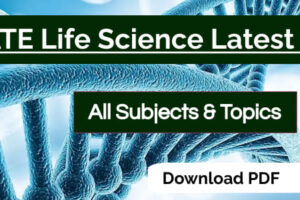GATE Botany [XL-P] Latest Syllabus 2024 Download PDF [Chapter Wise]

GATE Botany Life Science Syllabus [XL-P] is One of The Important Selective Subjects of the GATE Life Science With a Vast Syllabus Based on Plant Systematics, Plant Anatomy, Plant development; cell and tissue morphogenesis, Plant physiology and biochemistry & Many More Subjects. Every Year More Then 10000+ Aspirants Apply for GATE Botany The Sucess Rate is Just 6 %. But Don’t Worry If You Have Proper Knowledge About Exam Like, Syllabus, patterns, Books, How to Prepare for Botany, etc You Can Easily Crack, In This Article, We Will Discuss the Syllabus in Detail of GATE Life Science Botany
First We Start With Syllabus to Analysis Syllabus Before starting Preparation is so Much Important, Because Syllabus Will Tell you Which Topics you Have to Covered & How Many Topics Include
- Overview of Gate Life Science Botany Paper [XL-P] Exam 2024-
- What is The Latest Syllabus of GATE Botany 2024?
- GATE Botany Latest Syllabus Subject Wise /Section Wise –
- Section 1: Plant Systematics
- Section 2: Plant Anatomy
- Section 3: Plant development; cell and tissue morphogenesis
- Section 4: Plant physiology and biochemistry
- Section 5: Genetics and genomics
- Section 6: Plant Breeding, Genetic Modification, Genome Editing
- Section 7: Economic and Applied Botany
- Section 8: Plant Pathology
- Section 9: Ecology and Environment
- Benefits Of Analysis Latest GATE Life Science Botany Syllabus 2024
- Career Scope & Job Opportunities for Gate Life Science Aspirants –
- Some of the Public sector fields that offer a career in Life Science field are:
- List of Top Companies Hiring Biochemistry Graduates & Postgraduates are:
- Frequently Asked Question [FAQ] GATE Life Science Botany Syllabus –
Overview of Gate Life Science Botany Paper [XL-P] Exam 2024-
| Particulars | Details |
| Examination Mode Gate Life Science Botany | Computer Based Test (Online) |
| Duration Gate Life Science Botany | 3 Hours |
| Number of Subjects Gate Life Science Botany | 4 Papers [ 2 optional + Chemistry Compulsory + General Aptitute] |
| Section Gate Life Science Botany | General Aptitude (GA) ,Chemistry & Candidate Selected Subject [Optional] |
| Type of Questions Gate Life Science Botany | Multiple Choice Questions (MCQs)Multiple Select Questions (MCQs)Numerical Answer Type (NAT) Questions |
| Design of Questions Gate Life Science | The questions are designed to test the listed abilities Application Analysis Comprehension Recall Synthesis |
| Number of Questions Botany | 20 Questions |
| Total Marks | 100 Marks |
| Marking Scheme | All of the questions will be worth 1 or 2 marks |
| Negative Marking | Two types of MCQs: MCQs – 1 mark for each correct answer; 1/3 mark will be deducted for every wrong answer MCQs – 2 marks for each correct answer; 2/3 marks will be deducted for every incorrect response. There is no negative marking for Numerical Answer Type (NAT) questions and NO negative marking for MSQ & NAT. |
| Terms of Gate Life Science Exam | Once a year |
Check Best Study Notes [Books] for GATE Botany take Free Sample – Click Here
What is The Latest Syllabus of GATE Botany 2024?
To Analysis Syllabus is Very Important to know Details about the Paper. GATE Botany Syllabus is Divided into 09 Units/Chapters More than 50 Topics are Given in Each Unit most of Part of the Syllabus are Based on theoretical Concepts, Units Such As Plant Systematics, Plant Anatomy, Plant development; cell and tissue morphogenesis, Plant physiology and biochemistry Each Unit has Equal Weightage in Terms of Marks.
GATE Botany Latest Syllabus Subject Wise /Section Wise –
GATE Botany Subject Based on Topics Such as Plant Systematics, Plant Anatomy, Plant development; cell and tissue morphogenesis, Plant physiology and biochemistry & more This means that you’d have to cover a lot of ground to get a surface-level understanding of the fundamentals. While the syllabus is dense, it would help to break down each component that makes a lesson. This is why we’ve broken them down into the GATE life Science Botany syllabus according to the names of the units themselves. It would be easier to digest what topics under them are involved so that it would be easy for you to be prepared for the upcoming exams.
The subject code for GATE Life Science Botany. It comprises two online papers namely Paper-I & Paper-II with Multiple Choice Questions (MCQ)s.
- GATE Life Science Botany Paper 2 Syllabus is based on Botany. It tests your depth of knowledge and expertise in the respective subject.
Section 1: Plant Systematics
- Botanical nomenclature,
- history of plant taxonomy, diversity and classification of plants,
- APG system of plant classification;
- phylogenetics and cladistics,
- molecular taxonomy and DNA barcoding
- Centers for plant taxonomy and herbaria in India.
Section 2: Plant Anatomy
- Anatomy of the root,
- stem and leaves,
- floral organs,
- embryo and young seedlings
- Primary and secondary meristems,
- stellar organization,
- vascular system and their ontogeny,
- xylem and phloem structure,
- secondary growth in plants and wood anatomy,
- plant cell structure and differences from animal cells.
Section 3: Plant development; cell and tissue morphogenesis
- The life cycle of an angiosperm,
- development of male and female gametophyte; cell fate determination
and tissue patterning; - spacing mechanisms in trichomes and stomata.
- Embryogenesis, organization, and function of shoot and root apical meristems.
- Transition to flowering: photoperiodism and vernalization,
- ABC model of floral organ patterning,
- pollen germination, double fertilization, seed
development - Xylem and phloem cell differentiation,
- photomorphogenesis; phytochrome,
cryptochrome, - phototropin.
- Role of auxin, cytokinin, gibberellins
- brassinosteroids on plant development.
Section 4: Plant physiology and biochemistry
- Plant water relations, mechanisms of uptake and transport of water, ions, solutes from soil to plants,
- apoplastic and symplastic transport mechanisms. Mechanism of stomatal movements, nitrogen
- metabolism, photosynthesis; C3, C4 and CAM cycles, photorespiration, respiration: glycolysis, TCA
- cycle and electron transport chain. Plant responses and mechanisms of abiotic stresses including
- drought, salinity, freezing and heat stress, metal toxicity; role of abscisic acid in abiotic stresses.
- Structure and function of biomolecules (proteins, carbohydrates, lipids, nucleic acid), enzyme
- kinetics. Structure and biosynthesis of major plant secondary metabolites (alkaloids, terpenes,
- phenylpropanoids, flavonoids). Biosynthesis, mechanism of action and physiological effects of auxin,
- cytokinin, gibberellic acids, brassinosteroid, ethylene, strigolactone, abscisic acid, salicylic and
- jasmonic acid. Senescence and programmed cell death.
Section 5: Genetics and genomics
- Cell cycle and cell division. Principles of Mendelian inheritance, linkage, recombination, genetic
- mapping; extrachromosomal inheritance; Introduction to epigenetics; gene silencing- transgene
- silencing, post-transcriptional gene silencing, miRNA and siRNA; evolution and organization of
- eukaryotic genome structure, gene expression, gene mutation, and repair, chromosomal aberrations
- (numerical: euploidy and aneuploidy and structural: deletion, duplication, inversion, translocation),
- transposons. Model organisms for functional genetics and genomics; Introduction to transcriptomics,
- proteomics and metabolomics.
Check Best Study Notes [Books] for GATE Botany take Free Sample – Click Here
Section 6: Plant Breeding, Genetic Modification, Genome Editing
- Principles, methods – selection, hybridization, heterosis; male sterility, genetic maps and molecular
- markers, embryo rescue, haploid and doubled haploids, plant tissue culture: micropropagation,
- embryo culture and in vitro regeneration, somatic embryogenesis, artificial seed, cryopreservation,
- somaclonal variation, somatic cell hybridization, marker-assisted selection, gene transfer methods
- viz. direct and vector-mediated, generation of transgenic plants; Introduction to genome editing:
- CRISPR/Cas9, Cre-Lox system to generate chimeras; plastid transformation; chemical
- mutagenesis.
Section 7: Economic and Applied Botany
- A general account of economically and medicinally important plants- cereals, pulses, plants yielding
- fibers, timber, sugar, beverages, oils, rubber, pigments, dyes, gums, drugs and narcotics. Economic
- importance of algae, fungi, lichen and bacteria. Major Indian cash crops. Effect of industrialization
- on agricultural botany such as plastic on fiber economy. Genetically modified crops and its regulation
- eg. Bt cotton, Bt brinjal golden rice etc.
Section 8: Plant Pathology
- Nature and classification of plant diseases, diseases of important crops caused by fungi, bacteria,
- nematodes and viruses, and their control measures (chemical and biological) mechanism(s) of
- pathogenesis, resistance: basal, systemic, induced systemic resistance, gene for gene concept.
- Molecular detection of pathogens; plant-microbe interactions: symbionts and mycorrhiza, pathogens
- and pests. Signaling pathways in plant defence response; salicylic acid (SA) and jasmonic acid (JA)
- in plant-pathogen and plant-herbivore interaction, necrosis; host-parasitic plant interaction (such as Cuscuta).
Section 9: Ecology and Environment
- Ecosystems – types, dynamics, degradation, biogeochemical cycles, ecological succession; food
- webs and energy flow through the ecosystem; vegetation types of the world, Indian vegetation types and
- biogeographical zones, climate and flora endemism; pollution and global climate change, speciation
- and extinction, biodiversity and conservation strategies, ecological hotspots, afforestation, habitat
- restoration; plant interactions with other organisms; epiphytes, parasites, and endophytes.
Benefits Of Analysis Latest GATE Life Science Botany Syllabus 2024
Knowing the syllabus and exam pattern is essential for any preparation to be successful. You can definitely score more with the proper use of the GATE Life Science Botany Syllabus.
Some notable benefits of the new GATE Life Science Botany 2024 Syllabus are as below:
- GATE Life Science Botany Syllabus covers all topics that are important for the examinations.
- GATE Life Science Botany also mentions the weightage allotted to different units and chapters, knowing which you may form a strategy for preparing for chapters with high or low weightage.
- Question paper format is also explained in a syllabus.
- Having a clear understanding of your syllabus and the weightage of various sections will definitely help you decide how much time you should dedicate to each section.
- Generally, the exam papers for each course are designed as per the syllabus prescribed for that course.
- So, preparing according to the topic and instructions mentioned in the syllabus obviously helps to crack the exam with good scores
Career Scope & Job Opportunities for Gate Life Science Aspirants –
After achieving a Good Rank in GATE life Science Great Opportunities will welcome you in Many Field Biochemistry is a valuable degree commercially and that will come in useful for a range of well-paid jobs in an array of important industries. If one is looking for a career at the juncture of biology and medicine, then biochemistry could be interesting for him. The work field within Biochemistry is vast.
Jobs directly related to a Life Science degree include:
- Research Fellow
- Analytical chemist
- Biomedical scientist
- Pharma Associate
- QA / AC Associate
- Healthcare scientist
- Clinical biochemistry
- Food Safety Analyst
- Clinical research associate
- Forensic scientist
- Research scientist (Life Science)
- Scientific laboratory technician
- Toxicologist
- Lecturer / Professor
Check Best Study Notes [Books] for GATE Botany take Free Sample – Click Here
Some of the Public sector fields that offer a career in Life Science field are:
- Public Health Entities
- Drug Manufacturing Companies
- Blood Bank & Services
- Cancer research institutes
- Educational Institutes
- Industrial Laboratories
- Research Departments
- Agriculture and fisheries
- Environmental Pollution Control
- Forensic Science
- Hospitals
- Public Health Laboratories
- Cosmetic Industries etc.
The largest employers of biochemists in terms of the field are as follows:
- Research and development in life sciences: 49%
- Universities, colleges, and professional schools; state, local, and private: 15%
- Pharmaceutical and medicine manufacturing: 28%
- Management, scientific, and technical consulting services: 5%
- Wholesale trade : 3%
List of Top Companies Hiring Biochemistry Graduates & Postgraduates are:
- Novozymes
- Thermo Fisher Scientific
- Merck KGaA
- Sun Pharma
- Paraxel
- Siemens
- Syngene
- Sanofi
- Dr. Reddy’s
- Lambda Therapeutic
- Panacea Biotech
- Sami Labs
- Anthem Biosciences
- PI Industries
GATE Life Science Qualified – Salary Details
For Biochemistry Freshers the average entry-level salary figures are mentioned below:
| Average Freshers – Entry Level Salary at Research Institutes (Without NET / GATE) | Rs 15,000 – 20,000/- pm |
| Average Freshers – Entry Level Salary at Research Institutes (With NET / GATE) | Rs 20,000 – 30,000/- pm |
| Average Freshers – Entry Level Salary at Biopharma Companies | Rs 18,000/- to Rs 25,000/- pm |
For Life Science Candidates With Experience (1-3 years), Average Salary can vary widely based on the organization & the position one is working at.
| For Experienced Average Salary at Research Institutes (Without NET / GATE) | Rs 25,000/- to Rs 40,000/- pm |
| For Experienced Average Salary at Research Institutes (With NET / GATE) | Rs 30,000/- to Rs 60,000/- pm |
| For Experienced Average Salary at Biopharma companies | RS 30,000/- to Rs 80,000/- pm |
Frequently Asked Question [FAQ] GATE Life Science Botany Syllabus –
Q1. What is the GATE Life Science Botany syllabus 2024?
Ans- The Botany syllabus for GATE has two papers. Paper 1 is a common paper for all the candidates. The GATE Life Science Botany syllabus for Paper 2 is divided into 09 units /Sections
Q2. How Many Units are in GATE Life Science Botany Syllabus?
Ans- GATE Life Science Botany Syllabus is divided into 09 Units. After GATE Life Science Botany Chemistry [XL –Q] Compulsory for All Subjects & 2nd Subject
Q3. How Many Topics are given in GATE Life Science Botany Syllabus in Each Unit?
Ans – As per the Syllabus in Each Unit are More than 50 Topics & Many Subtopics .all topics are equally Important suggest going through all Topics.
Q4.How can we download the GATE Life Science Botany Syllabus 2024 PDF?
Ans- the Download GATE Life Science Botany Syllabus Fill the Form given above & Click on Submit Button after submitting it will redirect you to Syllabus where you can Download & Also Save on Your Google Drive
Q5.Is there any change in GATE Life Science Botany Syllabus recently?
Ans- No, Since 2019 June the Syllabus is the Same. No Change Made by GATE Life Science Botany. Generally Syllabus changes after 5 to 7 Years
Q6. How to prepare GATE Life Science Botany Syllabus 2024?
Ans- Check Details & Study Plan Above in Article
Q7.What is the GATE Life Science Botany Syllabus in Hindi 2024?
Ans- You Can Check Syllabus in Hindi Given in Article
Q8.How Many Questions Asked in Exam from Each Unit of GATE Life Science Botany Syllabus?
Ans– From Each Unit of GATE Life Science Botany 2 to 3 Questions Asked in Exam from different topics. Total 20 Questions Asked in Exam



